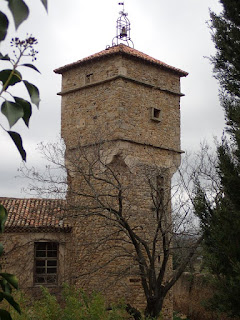Château de Cassan, Gabian and Roujan. 6km, 2h. some blue markers. Lovely afternoon walk from the chateau, down through the vineyards to the pretty oak covered hills and garrigue where lovely tall orchids grow. Then back up to the vineyards and a circuit around the chateau. The walk starts by parking at the chateau and walking through the low tunnel under the road. Here you follow a small road down past the vines to reach an old cross, now sadly lost. The road becomes a track and soon reaches another small road, turn right onto the road but don't take the little take on your left. Continue on the little road past the first track on your right but taking the small road right turn that follows. The road goes up slightly then steeply to a an old railway house(I believe this was once the railway built to carry oil that was extracted here in the first half of the 20th century, long since gone) At the next junction turn right and continue up the hill and past the local council dump. Keep right to reach the main road and then walk along the road towards Roujan for about 50m and cross the road to gain a small track. Continue on this track past the vineyards until you reach a tiny orange marked path on your right. This will bring you to another track, turn right and this will return you to the chateau. Once at the chateau, take the little path around the building and garden. It passes the tower, named the Lighthouse of hope, then continues around the the chateau and its grounds. The chateau was built in the 12th century as a hospital for the sick pilgrims who passed along this route on their way to the Santiago de Compostela. The local oil extracted from the earth in Gabian had healing qualities to mend their sores and with food and rest they were ready to continue on to Spain. The chateau was the residents of the cannons. It is said that the beautiful building has as many windows as days of the year. The grounds were later designed in the 1700's, while the beautiful building is made of sandstone, the largest of its kind in the Languedoc, the stone picks up the colours of the sun as evening light shines on it. The village of Gabian in the distance has been inhabited for around 7000 years but it was the Romans who exploited the water sources here and made aqueducts to Bezier. Later 5 watermills were built in the valley outside the ramparts of the castle. The Romans brought with them vines and gave the landscape the shape that it now has. The chateau takes its name from the little oaks that covered the hillside behind. "Cesse" being a gaelic name for oak. http://www.gabian.info/history.html














No comments:
Post a Comment